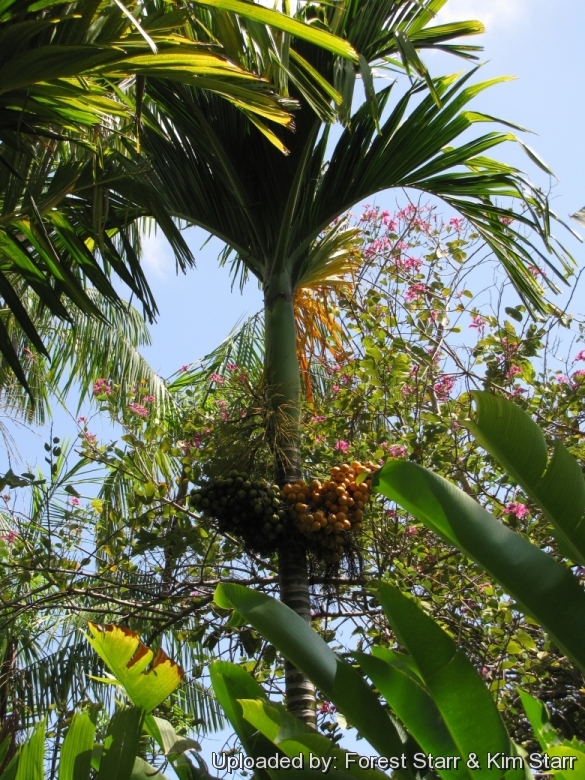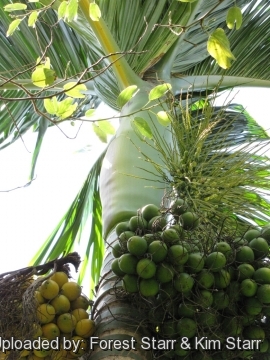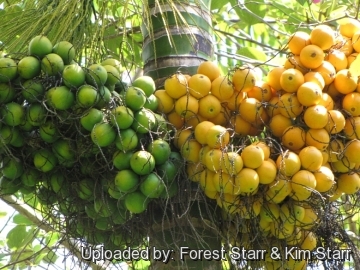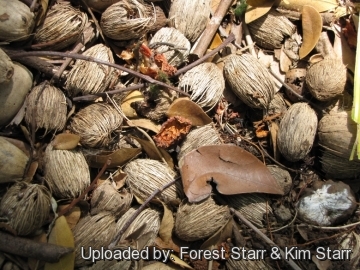Accepted Scientific Name: Areca catechu L.
Sp. Pl. 2: 1189. 1753 [1 May 1753] L.

Areca faufel (Areca catechu) Photo by: Forest Starr & Kim Starr
Habit at Iao Tropical Gardens of Maui, Maui. May 22, 2012.
Origin and Habitat: Believed to have originated in either Malaysia or the Philippines it is found growing grows in much of the tropical Pacific (Fiji, Papua New Guinea, Philippines, Samoa, Solomon Islands, Sri Lanka) Asia (India, Pakistan, Japan,) east Africa (Kenya, Madagascar, Tanzania) and parts of US.
Altitude range: 0-1,000 metres over sea level.
Habitat: Areca catechuSN|24199]]SN|24199]] almost always exists in cultivation; therefore, conditions of its natural habitat are difficult to assess. It however thrives in areas of high rainfall. Although tolerant to moderate elevations on mountains, it generally does best in low altitudes. Being a shade-loving species, arecanut always does well when grown as a mixed crop with fruit trees. Mean annual temperature: 14-36 deg. C. Mean annual rainfall: 750-4500 mm. Soil should be deep to ensure a well-developed root system with high organic carbon content and a pH range from acidic to neutral.
Synonyms:
See all synonyms of Areca catechu
back
Accepted name in llifle Database:Areca catechu L.Sp. Pl. 2: 1189. 1753 [1 May 1753]Synonymy: 14
back
Common Names include:
ENGLISH: Indian nut, Betelnut palm, Betelnut, Betel nut, Betel palm, Areca nut, Areca Nut Palm, Areca Palm,
ARABIC ( لعربية ): Tânbûl, Kawthal, Fûfal, الحضض الهندي
ARMENIAN (Հայերեն): Arygni
AZERBAIJAN ( Azərbaycanca): Katexu palması
BENGALI (বাংলা): সুপারি
BURMESE: Kunthi pin kun
CANTONESE (粵語): 檳榔
CATALAN (Català): Palmera d'areca
CHINESE (中文): 檳榔 Bing lang, Bing lang zi
CREOLE: Nwa betèl
CZECH (Čeština): Areka obecná
DUTCH (Nederlands): Pinangnoot, Betelpalm, Betelnootpalm, Betelnoot, Arecapalm, Arecanoot
ESPERANT (Esperanto): Kateĉuareko
ESTONIAN (Eesti): Beetli-areekapalm
FILIPINO: Bunga
FINNISH (Suomi): Betelpähkinän, Betelpalmu, Arekapalmu
FRENCH (Français): Noix de bétel, Noix d'arec, Aréquier, Palmier à bétel
GERMAN (Deutsch): Betelnuß palme, Betelpalme, Betelnüsse, Arekanuss, Arekapalme, Katechupalme, Betelnusspalme
GUJARATI (ગુજરાતી): Topaarii, Opaadii
HINDI ( हिन्दी): सुपारी Supaarii, Supaadii
HUNGARIAN (Magyar): Bételdió, Arékapálma, Bételpálma
INDONESIAN (Bahasa Indonesia): Pinang
ITALIAN (Italiano): Palma di Betel, Palma arec, Noce di betel, Noce di arec, Noce del betel, Avellana d'India, Areca
JAPANESE (日本語): Binrouju, Binrou, Areka yashi, ビンロウ
JAVANESE (Basa Jawa): Jambé
KANNADA (ಕನ್ನಡ): ಅಡಿಕೆ
LATVIAN (Latviešu): Beteļpalma, Arekas palma
LITHUANIAN (Lietuvių): Betelio palme, Arekine palme, Katekinė areka
MALAY (بهاس ملاي /Bahasa Melayu ): Pinang, Pucuk (Indonesia), Pokok pinang, Pinang sirih, Kavugu
MALAYALAM (മലയാളം): അടക്ക adakka, കവുങ്ങ്
MARATHI (मराठी): पोफळ
MIN NAN (Bân-lâm-gú): Pin-nn̂g
NEPALESE (Nepal bhasa नेपाल भाषा): Supaarii
POLISH ( Polski): Areka katechu
PORTUGUESE (Português): Noz de bétele, Noz de areca, Arequiera, Arequeira, Areca catecú
RUSSIAN (Русский): арека катеxу, Бетелевая пальма
SANSKRIT (संस्कृतम्): पूगवृक्
SINHALESE: Puwak
SLOVENIAN (Slovenščina): Palma areková, Palma betelová, Areka betelová
SPANISH (Español): Palma catecu, Nuez de betel, Bonga, Areca, Palma de betel, Nuez de areca
SUNDANESE (Basa Sunda): Jambé
SWAHILI ( Kiswahili): Mpopoo
SWEDISH (Svenska): Betelpalm, Betelnöt
TAGALOG: Bunga
TAMIL (தமிழ்): Kathakambu, Kamugu, Bakkumaroma
TELUGU (తెలుగు): పోకచెట్టు
THAI (ภาษาไทย): หมากสง, Phonmaak, Maaksuan, Maaklang, Maak khiaw, Luuktan, Luukmaak, เซียด Siat, สีซะ Si sa (Karen), สะลา Sa la (Khmer), แซ Sae (Karen), ปีแน Pi nae (Malay), พลา Phla, หมากสง Mak song (Maag soeng), หมากมู้ Mak mu (Shan), หมากเมีย Mak mia, หมาก Mak (Maak), มะ Ma, เค็ด Khet
TOK PISIN: Buai
UPPER SORBIAN (Hornjoserbsce): Wšědna betelpalm
URDU (اردو): Supaadii
VIETNAMESE (Tiếng Việt): Binh lang, Tân lang, Cau
Description: Areca catechuSN|24199]]SN|24199]] is a handsome medium-sized and graceful palm tree cultivated in all the warmer parts of Asia for its “nuts”.
Trunk: Solitary, slender and erect to 20(-30) m tall, 10-30 cm in diameter, green at first, subsequently greyish and ringed by the remains of leaf scars, the trunk becomes visible only when the palm is about 3 years old.
Roots: Root system adventitious, typical of monocots. Roots hairs absent. Pneumatophores also present. Sometime aerial roots are produced from base of stems.
Crown: The adult palm has 7-12 open leaves.
Leaves: 1,5–2 m long, pinnate, with a rigid but recurved rachis and several rigid, closely packed leaflets with jagged tips.
Inflorescence: Clustered, arising from the leaves axil from below the crown shaft
Flowers: Areca catechuSN|24199]]SN|24199]] is a monoecious plant with male and female flowers occurring on the same spadix. Flowers are whitish-yellow sweet scented, unisexual, and enveloped by two spathes. Male flowers are very numerous, sessile, without bracts and located at inflorescence apex, calyx 1-leaved, small, 3-cornered, 3-parted. Petals 3, oblong, rigid striated. Stamens 6, anthers sagittate, whilst female flowers, less numerous, solitary or 2 or 3 at or near the base of each ramification of the spadix.
Blooming period: Every year 3-4 inflorescences are produced. The first inflorescence on young palms may produce only male flowers. The male flowers open for a few hours, shedding pollen most in the morning. The average male flowering period is 2-4 weeks; after this the stigmas in female flowers become receptive for 3-4 days. It is thought that most of the flowers are wind pollinated.
Fruit: Hard, yellowish-red, scarlet when ripe, smooth the size of a hen's egg containing a fibrous mesocarp and a thin woody endocarp enveloping one seed.
Seed: About the size of an acorn, conical in shape (oval and flattened at one end) with flattened base and brownish in colour externally. Internally mottled like a nutmeg.
Bibliography: Major references and further lectures
1) Forest & Kim Starr “Areca catechu (Betel nut palm)”. Plants of Hawaii. <http://www.starrenvironmental.com>. Downloaded on 19August 2014. Alice Kurian, K.V.Peter “Commercial Crops Technology” New India Publishing, 01/gen/2007
2) Robert Lee Riffle, Paul Craft “An Encyclopedia of Cultivated Palms” Timber Press, Portland 2007
3) John Dransfield, Natalie W. Uhl, Conny B. Asmussen, William J. Baker, Madeline M. Harley, Carl E. Lewis: “Genera Palmarum. The Evolution and Classification of Palms.” Royal Botanic Gardens, Kew 2008
4) Don Ellison, Anthony Ellison “Cultivated Palms of the World” UNSW Press, 2001
5) Thomas Nordegren “The A-Z Encyclopedia of Alcohol and Drug Abuse” Universal-Publishers, 01/Jan/2002
6) James A. Duke “Handbook of Nuts: Herbal Reference Library” CRC Press, 10/Nov/2000
7) Maurice M. Iwu “Handbook of African Medicinal Plants, Second Edition” CRC Press, 18/Feb/1993
8) Wikipedia contributors. "Areca catechu." Wikipedia, The Free Encyclopedia. Wikipedia, The Free Encyclopedia, 8 Aug. 2014. Web. 20 Aug. 2014
9) Jones, D. “Palms Throughout The World” Reed New Holland, Australia. 2001
10) Heatubun, C.D., Dransfield, J., Flynn, T., Tjitrosoedirdjo, S.S., Mogea, J.P. & Baker, W.J. “A monograph of the betel nut palms (Areca: Arecaceae) of East Malesia.” Botanical Journal of the Linnean Society 168: 147-173. 2012
 Fruit and sheath at Iao Tropical Gardens of Maui, Maui. May 22, 2012 (Areca catechu) Photo by: Forest Starr & Kim Starr
Fruit and sheath at Iao Tropical Gardens of Maui, Maui. May 22, 2012 (Areca catechu) Photo by: Forest Starr & Kim Starr Fruit at Iao Tropical Gardens of Maui, Maui. May 22, 2012. (Areca catechu) Photo by: Forest Starr & Kim Starr
Fruit at Iao Tropical Gardens of Maui, Maui. May 22, 2012. (Areca catechu) Photo by: Forest Starr & Kim Starr Trunk at Iao Tropical Gardens of Maui, Maui. May 22, 2012. (Areca catechu) Photo by: Forest Starr & Kim Starr
Trunk at Iao Tropical Gardens of Maui, Maui. May 22, 2012. (Areca catechu) Photo by: Forest Starr & Kim Starr Fruit at Iao Tropical Gardens of Maui, Maui. May 22, 2012. (Areca catechu) Photo by: Forest Starr & Kim Starr
Fruit at Iao Tropical Gardens of Maui, Maui. May 22, 2012. (Areca catechu) Photo by: Forest Starr & Kim Starr Trunk at Walmart Kahului, Maui. January 17, 2008. (Areca catechu) Photo by: Forest Starr & Kim Starr
Trunk at Walmart Kahului, Maui. January 17, 2008. (Areca catechu) Photo by: Forest Starr & Kim StarrSend a photo of this plant.The gallery now contains thousands of pictures, however it is possible to do even more. We are, of course, seeking photos of species not yet shown in the gallery but not only that, we are also looking for better pictures than those already present.
Read More... Cultivation and Propagation: This palm is an excellent relatively fast-growing garden plant adapt to different tropical climates. It is also one of the most elegant indoor palms.
Soil requirements: It prefers well-drained fertile, soils except those that are constantly soggy. However it is widely adaptable including those that are neutral, acidic, clayey and slightly alkaline.
Watering: It prefers regular waterings and should be watered before the soil completely dries. Don't let sit in water. Indoor, potted kentias should not be over-watered. They may contract the fungus Phytophthora, if over-watered.
Light: Outside they grow best in half sun and tolerating direct sun only after about five years old. Young specimens need protection from direct sunlight and grow best in shady to partly shady locations. If home-grown, they look their best in bright diffuse light.
Fertilization: Need a perfect low-release fertilizer (e.g., 18-18-18) diet including all micro nutrients and trace elements. It is subject to magnesium and potassium deficiency
Hardiness: They grow well in tropical and subtropical climates; normal temperatures should not go below 10°. (USDA Zones 10 – 11)
Maintenance: Remove dried fronds.
Garden uses: It is grown in open air, in the sub tropical and warm-temperate zones, for the decoration of parks and gardens, in a partly shaded location when young, and regularly watered. But the most frequent utilization, since from the introduction in Europe, is as indoor plant, its elegance, since the very first years of age, the adaptability to conditions of scarce luminosity, and the absence of particular attentions, render it, still now, one of the most utilized palms, if not the most common, for the decoration of indoor spaces.
Other uses: Areca catechu is grown for its commercially important seed crop, the areca nut. The seed contains alkaloids such as arecaidine and arecoline, which, when chewed, are intoxicating and has psychoactive properties (stimulating effects). They stain the lips and teeth red and also the excrement, they are hot and acrid when chewed. However there may be undesirable side effects associated with chewing on the fruit such as an increase in heart rate, blood pressure, sweating and body temperature. For these reasons this palm is widely cultivated, making up huge plantations, in many tropical regions, not only in Asia, but also from Pakistan and India to Malaysia, and as far as the Pacific Southern Islands and in Africa.
In addition, its vegetating buds are often used as palm cabbage.
The Betelnut is also used as an offering in Hinduism.
Disease & Pests: It is quite resistant to pests but may require regular fertilization to prevent yellowing caused by potassium deficiencies; protect against spider mites, scale insects, Cylindrocladium leaf spot, stigmina and other fungal leaf spots. They are also susceptible to lethal yellowing disease. Protect from frost.
Propagation: By seeds that germinate well and are readily available. Also by divisions of clumps.














